Is your mind stuck with the question of where to put plants in a house? or looking for the help for how to arrange indoor plants or seeking ideas for where to displaying houseplants or you may be searching the web for plant decoration in the living room, office or even anywhere inside the room you are looking for the great tips and tricks by which you can decorate your office, room more awesome.
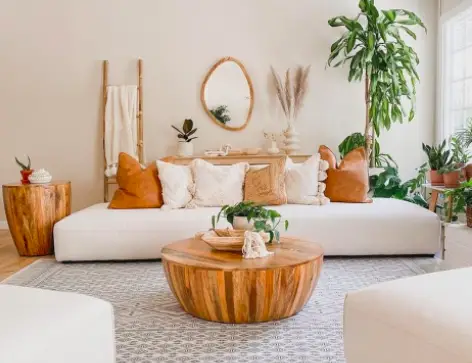
Here In This Long Article I have worked hard and writing this long guide by which you will get perfect indoor plant decoration ideas and indoor plant design guides. Walk into any garden store with a reasonable selection of houseplants, and you will see evidence of the huge diversity of plant shapes and forms that exist. Among these shapes, you will find some that are more appealing to you than others, but you will also need to bear in mind how suitable they are for the specific locations you wish to enhance in your house.
Indoor Plants Decoration Ideas Home Plants Decoration Guides & Ideas for Stylish Indoor Plant Displays
A tall, striking, “architectural” plant may be called for to provide a dramatic creature in a prominent position in a large, simply furnished living room. A smaller, more crowded room may be better served by low-growing foliage and flowering plants grouped together on a window or table. No matter how attractive a par- circular specimen appears in the store, always try to imagine it in your own home before buying it.
Plant shapes fall into six principal: ups, but there is some overlap among my groups.
Upright
A plant such as Sansevieria trifasciata, mother-in-law’s tongue or snake plant, ‘• void be defined as upright, with its dramatic tall, sharp spikes. Such plants gave no hint of spreading or trailing •terns to soften the outline, even after several years’ growth.
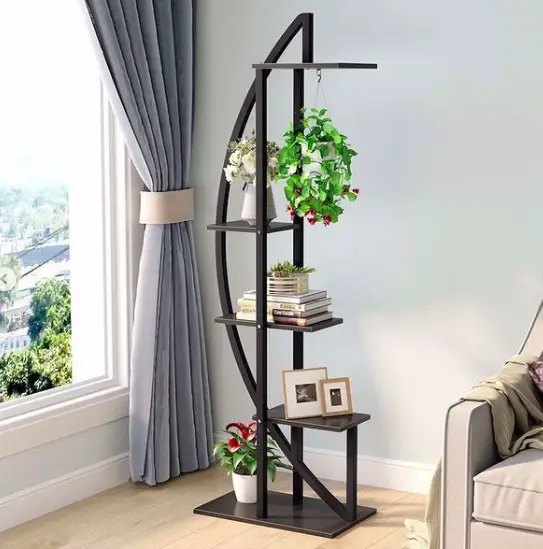
Bushy
Many indoor plants are classified as rushy. They may have several stems or most one main stem, which divides lower own into a number of branches. The branches spread out to form a more or less rounded, bushy shape, which is well furnished with foliage. Dieffenbachia w..culata, dumb cane, has a bushy habit, as do pot chrysanthemums. But with the -latter, it is the way the raisers treat the plants, rather than their natural habit of growth, that gives them their form.
Trailing
V stems cascade down, sometimes con- .:ruling the plant’s pot entirely. In some instances, the stems are prostrate, such as those of Zebrina pendula, wandering Jew, or Ficus pumila, the creeping fig.
The stems of other plants strike out upward to begin with, then bend over gracefully as they develop, giving the effect of a fountain. The ever-popular Chlorophytum comosum, spider plant, has this appearance, although it is not just the grassy foliage that produces the effect. As plants start to mature, they produce lots of “baby” plants on the ends of long, pliable stems; these cascades down to make the plant a true trailer.
Climbing
A climber generally has lax stems, which will trail if they are not supplied with supports, but which will scramble eagerly upward when they are able to. Sometimes these plants need encouragement to start climbing; often nothing will stop them.
They may have twining stems, clinging tendrils, or aerial roots to support them in their upward quest.
Standard
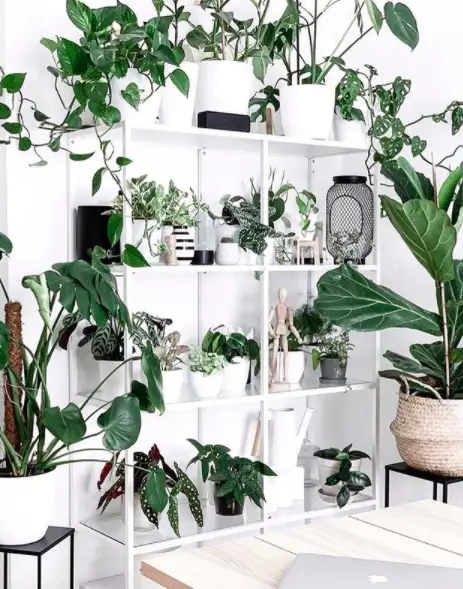
Standards are treelike plants that have the main stem and a branching head. Ficus Benjamina, a popular example, also has an attractive weeping habit, hence its common name of weeping fig.
Architectural
The term “architectural” applies to forms that are unusual and dramatic. The shape and outline of such plants are bold and eye-catching, and architectural plants are usually grown as stand-alone specimens. They are always large plants, tending to be tall rather than spreading, such as Chamaerops humilis, the European fan palm, which has big, boldly cut, fan-shaped leaves and sturdy, hairy stems.
Plants give a room an inviting air. Here a bushy Fern and round-headed standard azalea lead the eye to the staircase wall, which is lightly clothed with a lax-stemmed creeper.
Foliage Plants
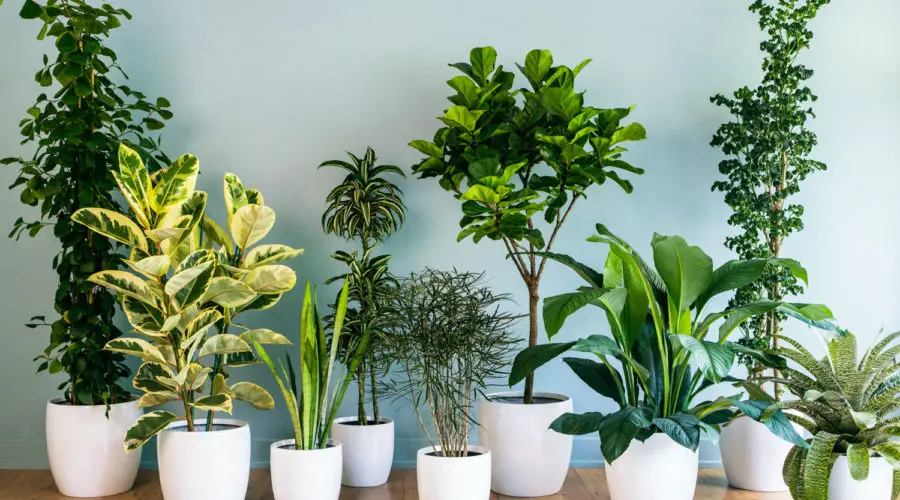
Grown mainly for their leaves, foliage plants may also produce flowers. Sometimes these flowers are an added short-term attraction. Sometimes they are insignificant. Occasionally they detract from the appearance of the plant and are best pinched off while in the bud. Foliage plants may be valuable for the shape, texture, or color of their leaves. They are normally of year-round value in the home, although a few, such as caladiums, die back in winter.
Leaf shape
There are literally dozens of different leaf shapes, some of which are particularly attractive and striking. Leaf size, too, varies widely and, together with the shape, plays an important part in the overall effect created by the plant.
Among the many shapes to be found are the bold, handlike leaves of Fatsia japonica, Japanese aralia; the deeply incised leaf fans of How Belmore ana, the curly palm; the heart-shaped foliage of Philodendron scandens, the heartleaf philodendron; and the sharp spikes of Yucca elephantipes, the spineless yucca.
The huge leaves of Monstera deliciosa develop slits and holes that give the plant its common name, Swiss cheese plant; and the foliage of Syngonium podophyllum is responsible for the names of goosefoot and arrowhead vine. The needle-like leaves of Asparagus densiflorus ‘Sprengeri’ make it look like a fern.
Many leaves are divided into leaflets, such as the narrow, scalloped fingers of Dizygotheca elegantissima and the umbrella- rib leaves of Schejplera arboricola, the umbrella tree.
The margins of leaves may be waved, crenulated, serrated, or toothed; the bases and tips of each leaf differ in their shapes and patterns. The size of leaves can range from the tiny, bright green pinheads of Nertera granadensis, the bead plant, to the extravagant foliage of Monstera deliciosa and Ficus lyrata, the fiddle leaf fig.
Leaf texture
Glossy, leathery, corrugated, downy, velvety, spiny, waxy—the texture of leaves can differ as much as their shape and color and can give fascinating visual, as well as tactile, effects. The boldly marked foliage of Begonia rex, painted-leaf begonia, has short, stiff hairs all over the surface, which gives it a rough, sandpaper texture.
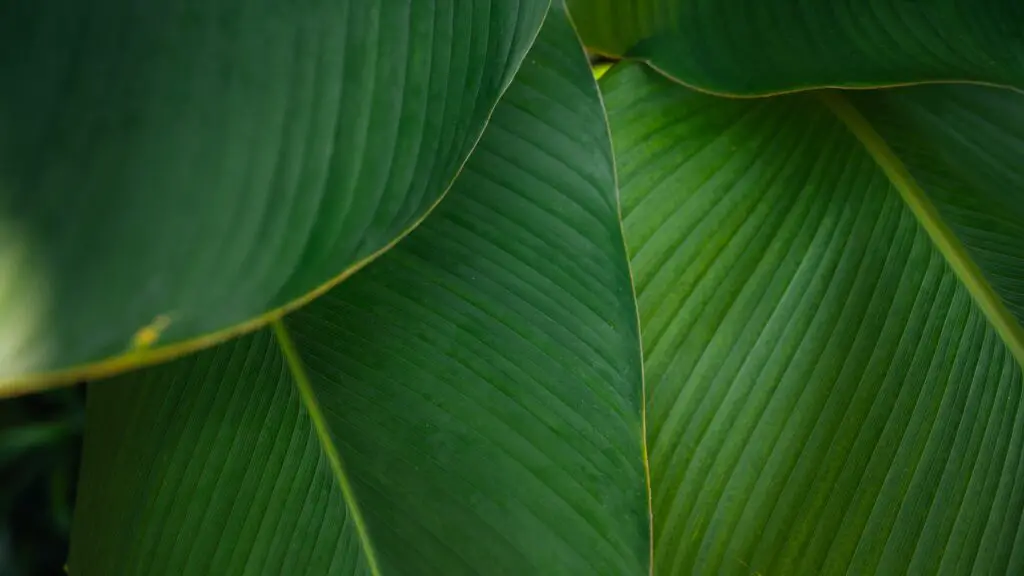
In contrast, the hairs on the foliage of Gynura ‘Purple Passion,’ the purple passion vine, are soft, producing a plush effect that gives the plant the common name of velvet plant. The veins stand out prominently on the backs of the leaves of Begonia rex, whereas the raised veins of Maranta leuconeura, the prayer plant, appear on the top surface of the leaf. In between the raised veins, tiny hairs give the maranta leaf a satiny look and feel.
Peperomias have deeply corrugated, winkled leaf surfaces, as do many pileas, including Pilea cadieri, the aluminum plant. The leaves of the rubber plant, Ficus elastica, are thick, glossy, and leathery. At the other end of the scale, the delicate, paper-thin, translucent foliage of Caladium x hortulanum has given it the common name of angel wings.
Leaf color
If asked what color leaves are, most people would unhesitatingly reply “green.” The majority of leaves may be predominantly green, but that is by no means the whole story. Even among plants with completely green foliage, there are many different shades and subtleties of color. Some greens are so dark as to be almost clack – as in the rubber plant Ficus is Stic a ‘Black Prince’ – while the delicate ‘ liage of Adiantum raddianum, the delta maidenhair fern, is the fresh, pale green : springtime.
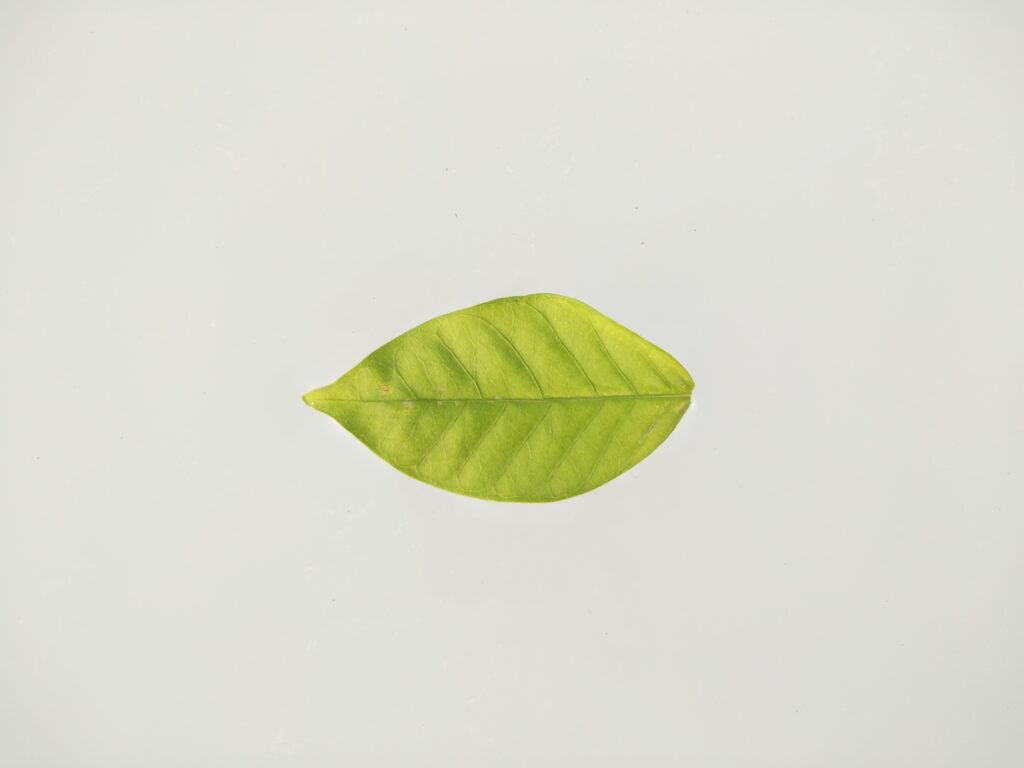
Leaves can be variegated with gold, cream, or white, sometimes around the margin of the leaf, sometimes over its entire surface. These markings may take the form of irregular splashes or mottling, or they may occur in a distinctive pattern. The leaf veins are often highlighted by a contrasting color, and sometimes the leaves are so strongly variegated that they appear to be yellow or white with green markings. Many ivies are attractively variegated: Hedera helix ‘Little Diamond’ has small leaves with silvery edges, and the much larger leaves of H. algeriensis ‘Gloire de Marengo’ are mottled all over with several shades of green, gray, cream, and white. Variegation in shades of pink and red may also occur Dracaena marginata ‘Tricolor’ has long slender leaves picked out with fine cream lines and a bright pink edge.
In Maranta leuconeura erythroneura, the herringbone plant, the leaves are fascinatingly marked, with bright red veins and an irregular backing of pale green or yellow on the central rib. The green coloring in leaves is chlorophyll, which is essential for plants to be able to make their food satisfactorily. However, some plants seem to be able to survive with very little chlorophyll, which gives rise to interesting and unusual leaf colors.
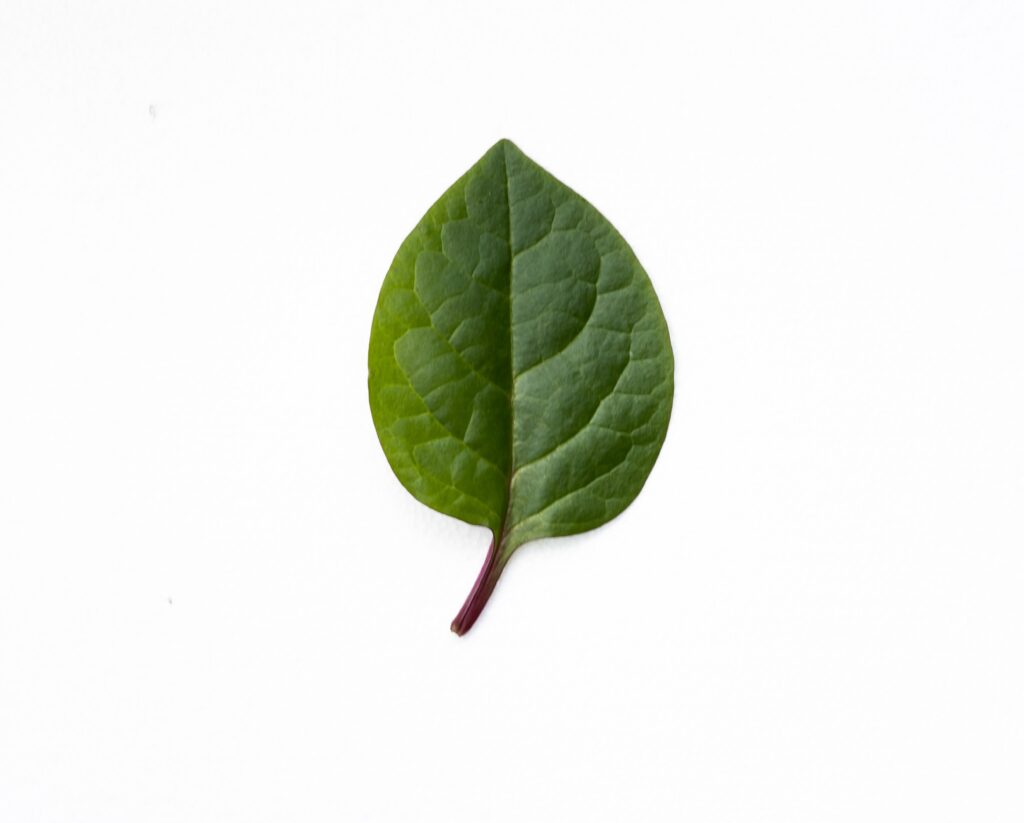
Iresine herbstii, the beefsteak plant, for example, is so-called because its foliage and stems are a bright red. And some varieties of Begonia rex have leaves of pink, red, silver, and purple, with no green to be seen. The delicate, paper-thin leaves of caladium are often white or cream with a pink central flush and perhaps just a fine margin of green or green veins. Easier to grow are Coleus blumei, the cheerful flame nettle, and Codiaeum variegatum pictum, known with good reason as Joseph’s coat. Both of these can be found with leaves vividly patterned in a wide range of brilliant—and often gaudy—shades of red, yellow, orange, and brown. The chlorophyll in these nongreen plants is present, but it is well masked by the other pigments.
Flowering Plants
Just as there is an enormous choice of leaf types, shapes, and colors among foliage plants, so the number of flowering plants is immense. Flowers appear in all colors of the spectrum. They may be small individually but carried in large numbers to produce their effect, or they may be large and bold enough for a single flower stem to be the center of attention.
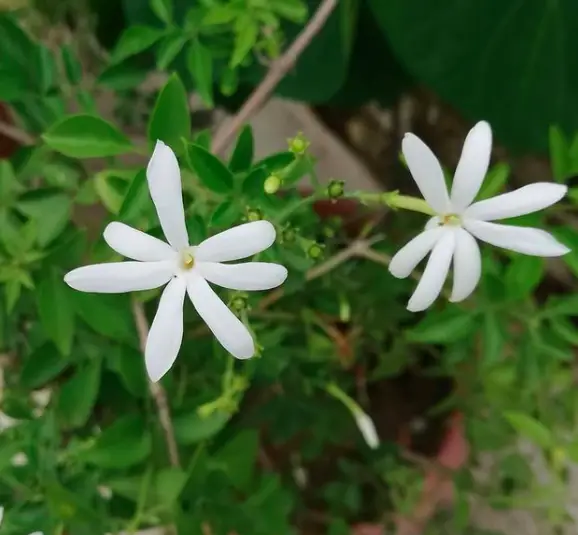
There is, too, a vast array of shapes from the simple, five-petaled trumpets of jasmine or daisylike cinerarias to the curious appearance of some members of the orchid family. Double, single, pendant, star-shaped, trumpet-shaped, pouched, or rosette-forming—the Choices are endless. Spring provides enchanting and colorful plants for the house. Pots of bulbs with miniature cyclamens, African violets, and primroses make a heartwarming display. Sometimes a plant is not grown for its dowers but for the leafy, flower-like bracts that may be far more colorful and eye catching than the true flowers. Euphorbia Pulcherrima, poinsettia, for example, has small yellow flowers in the center of showy red, cream, or pink bracts.
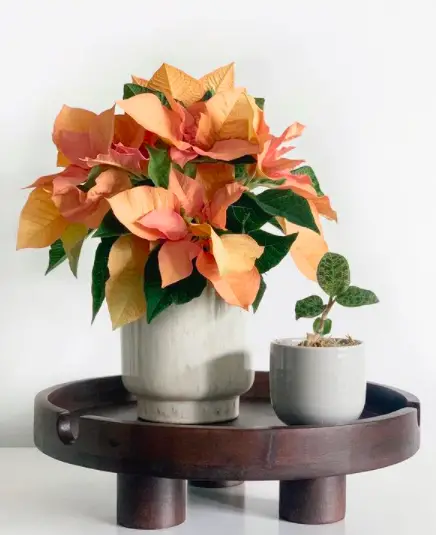
And the scrambling bougainvillea also relies on papery, brightly colored bracts for its charm. Insignificant flowers may be followed by interesting fruits, as is the case with Solarium capskastrum, the false Jerusalem cherry. Most flowers are grown for their color and appearance, but some are enjoyed mainly for their scent. Twining white jasmine can perfume a whole room, and the sweet scent of the waxy cream trumpets of stephanotis is almost overpowering. Gardenias are not easy plants to bring into bloom, but the white-to- cream, double or semidouble blooms are intensely fragrant. Many spring bulbs—narcissi, hyacinths, and crocuses among them—can be flowered indoors, where their delicate perfume can be more easily appreciated than when they are grown in the garden. Narcissus tazetta ‘Paperwhite’ is a particularly good choice for fragrance and is ‘simple to grow, flowering four to six weeks after planting (no cold, dark period is necessary).
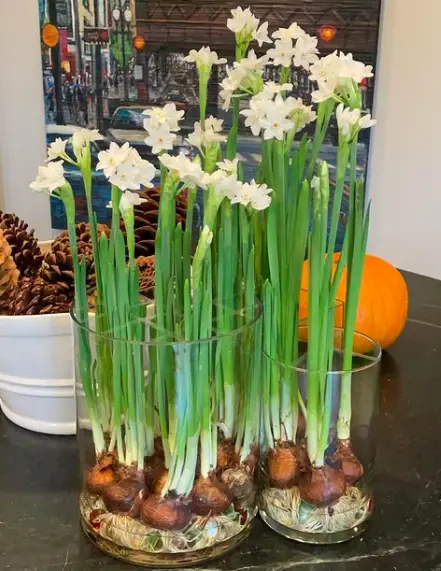
By their nature, flowering plants tend to have a limited season of interest. The length of the flowering period can vary considerably. Some plants, such as orchids, have very long-lasting flowers; others have flowers whose individual lives are brief, but because new flowers are constantly opening to replace them the period of interest is prolonged.
Many plants have attractive foliage, which makes them good to look at even when the flowers are over. The pineapple-like blooms of Aphelandra squarrosa, the zebra plant, last for several weeks; but when they die, the dark green leaves with their herringbone pattern of white veins make the plant still highly decorative. Yellow and orange calceolarias, slipper flowers (right), complement the glowing golden wood of an antique chest of drawers and mirror. A striking clivia (left) with its fan of leaves and head of orange flowers is held enough to stand alone.
Buying plants Tips And Guide
Indoor plants are available from a wide range of outlets, including supermarkets, florists, discount stores, and mail-order nurseries as well as garden centers. In winter, protect the plant from cold weather on its journey home, preferably enclosing it entirely in a plastic sleeve or cardboard box made for the purpose. Once home, settle the plant in the location you have selected for it and avoid the temptation to keep moving it from place to place.
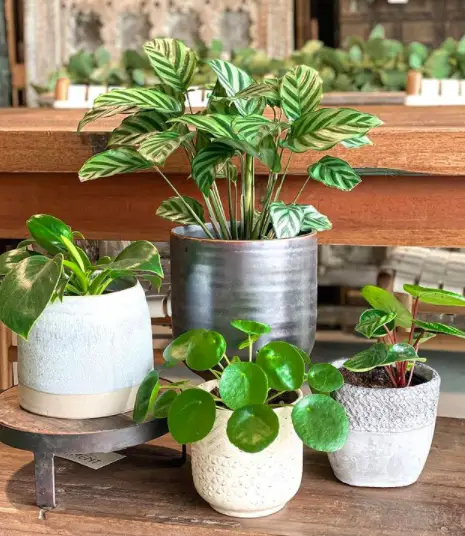
Be prepared for it to look a little unhappy for a short spell as it adjusts to the different environment of your house; it is not unusual for a few leaves to fall or flower buds to drop off. As long as you have chosen a position that provides a suitable temperature, humidity, and light level for the particular species, it will soon recover and start to grow happily. When buying plants, pick medium-sized, robust, healthy plants with no obvious signs of damage, pests, or disease.
Test the soil surface with your finger: it should be just moist. Reject specimens that are bone-dry or sodden. Flowering plants should have plenty of developing buds and not too many fully open flowers. Look at the base of the pot to see whether roots are protruding from the drainage holes. A lot of visible root means the plant should have been repotted and its growth is likely to have been checked. Avoid plants from display units near doorways. They are likely to have been subjected to fluctuating temperatures.
Choosing The Right Place for Houseplants
Every home will provide a surprisingly wide variation of environments, and it is important to select the right plant for the right place. This does not only mean choosing the plant that looks best in a particular location; it also means finding plants that will be happy in the conditions provided. The major variables are light levels and temperature; these are dealt with in more detail.
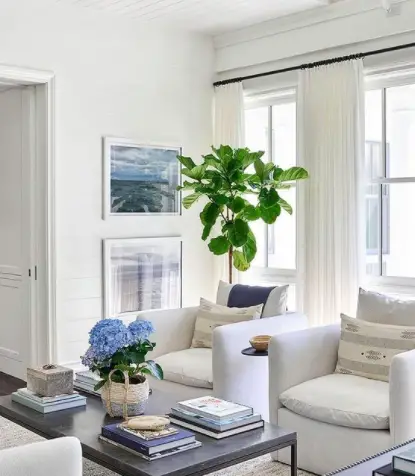
Living rooms are probably the most popular areas for plant displays since they are the rooms in which we tend to relax and enjoy our surroundings. Many plant lovers, though, like to have decorative plants in virtually every room of the house. Of course, each house will be different, but there are some general points that apply to most homes.
Where to Put Houseplants in Halls
The hall is often the first part of your home a visitor sees, and plants help to create a pleasant, welcoming atmosphere. It can be a difficult location for plants, however, since it is often narrow, restricting the room for plant displays, and receives little natural light. Halls are usually cooler than the living areas of the house.
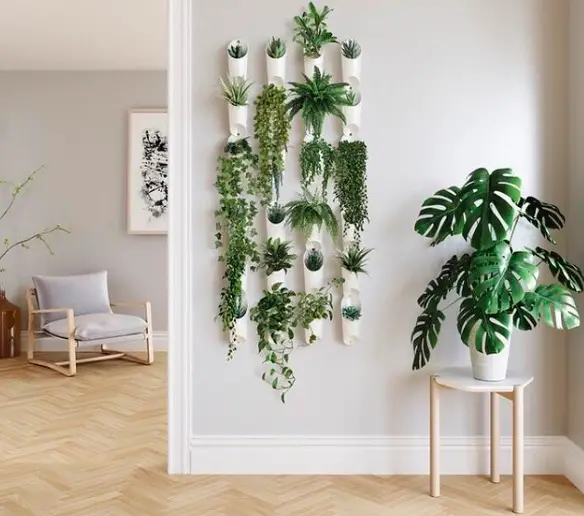
Opening and closing the front door causes drafts and temperature fluctuations, and if the stairway is situated in the hall, warm air will tend to rise, causing an updraft. The front door is often used only by visitors, so plants near it tend to be forgotten.
Where to Put Houseplants in Living rooms
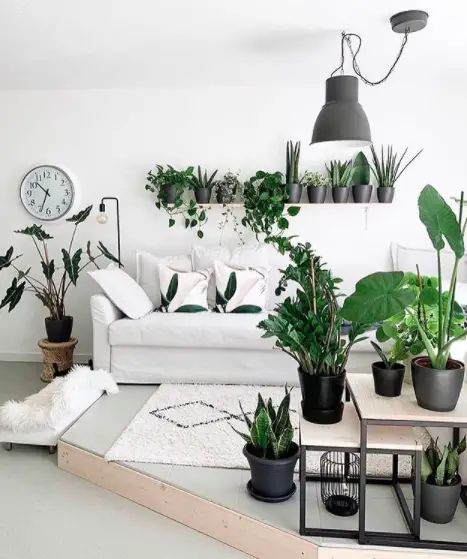
These rooms are generally fairly light, with plenty of windows, and they often face the sun. They are usually fairly large rooms, where taller, architectural plants can be most easily accommodated. A bedside table is an ideal place for an exotic orchid (above). What better way to greet the morning than by. Nothing could be more inviting than the prospect of a meal under a leafy vine in a sunroom (left)full of colorful plants such as abutilon and campanula, which love the light.
Where to Put Houseplants in Kitchens
Many families spend a lot of time in the kitchen. And while you are likely to be busy there preparing meals and cleaning up, plants help to create a welcoming, pleasant environment. A large kitchen may also be used for eating and as a general family room where many activities take place. This sort of kitchen tends to be kept evenly warm and is often reasonably light; it is, therefore, suitable for many types of plants.
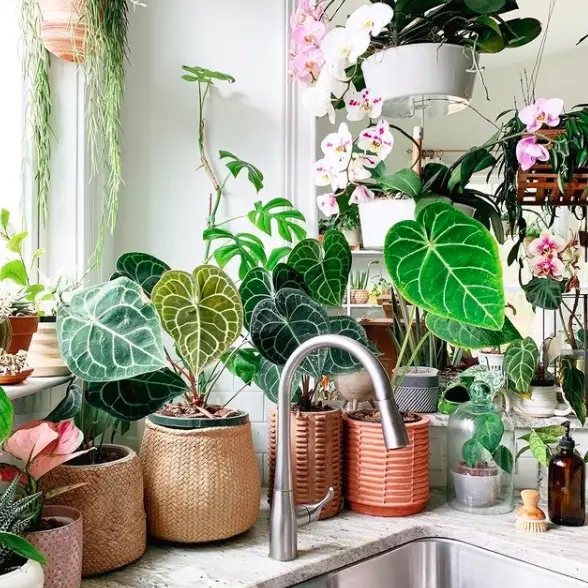
Older houses or apartments may have small, cramped kitchens, which often face away from the sun and have small windows. Temperatures there tend to fluctuate widely, rising considerably during cooking but cooling down quickly afterward. Humidity levels in kitchens are often high, due to steam from cooking, washing, and so on.
So plant leaves can quickly become coated with greasy, sticky deposits and thus need frequent cleaning. Consequently tough, glossy-leafed specimens may do better than those with soft, delicate foliage. The kitchen is primarily a working area. Plants must not get in the way and should never compromise safety when people are working around hot surfaces.
Wicker pot covers to tie in with the wicker furniture in this living room. Foliage plants, which need less light, stand at the back of the room, while the pelargonium enjoys bright light, warm colors, and plants such as bamboo, orchid, and bromeliad, which thrive in a warm, humid atmosphere (below), make this a bathroom to luxuriate in and enjoy.
Where to Put Houseplants in Sunrooms
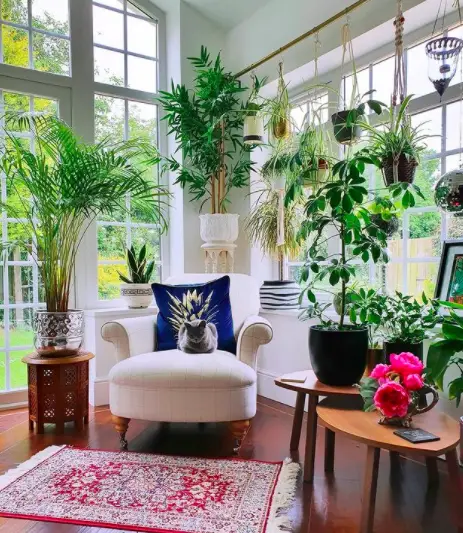
Increasing numbers of houses now have sunrooms, not just for growing plants, as was the case years ago, but to provide extra living space. Most modem sunrooms are fully heated and furnished, but the high light levels they enjoy still make them excellent places for a wide selection of plants.
Temperatures can become extremely high in summer, and ventilation and blinds or some other form of shading are nearly always necessary to prevent leaf scorch and to lower the temperature to a more comfortable level. Unheated sunrooms will obviously be cold in winter and are unlikely to be suitable for many houseplants, although some warmth will be obtained from adjoining rooms.
Where to Put Houseplants in Bedrooms
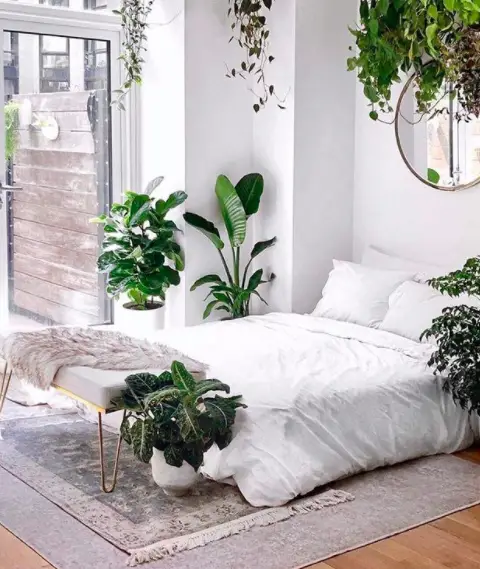
Although the bedroom may be the room in the house where we spend most hours, we are asleep and unappreciative of the delights of plants for much of the time. Many bedrooms face east, and a bedroom windowsill is a popular place for a few undemanding plants. A special effort needs to be made to remember to water them, however, since they can easily be forgotten in the family’s often-rushed morning routine.
Where to Put Houseplants in Bathrooms
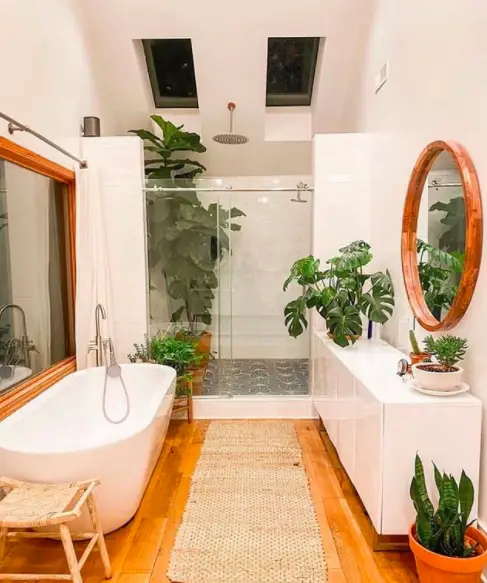
Although many bathrooms receive little sun, modern bathrooms have the advantage of being evenly warm throughout the day, with high levels of humidity, providing good conditions for plant growth. Light levels are often good, with frosted or obscured glass giving the bright, diffused light favored by many plants.
But beware: the temperature will rise rapidly when a bathtub or shower is in use, then it will fall quickly, leading to the cool, moist conditions that make plants prone to fungal disease.
Displaying Plants – The right place and positions for Plants
The most magnificent plant can lose its impact if it is positioned wrongly. Choose a place that provides the conditions it likes and it will thrive. But you should also choose a place where it will be shown to its best advantage.
Specimen plants
Many plants can be successful when displayed on their own, as single specimens. These are normally fairly large subjects, with a bold outline or dramatic foliage, the so-called architectural plants. Such plants can make an excellent focal point, particularly if spotlights are used for highlighting. Ficus elastica, the rubber plant, is perhaps less popular than it once was, but its relative, Ficus benjamina, the weeping fig, makes a splendid specimen plant. Ficus lyrata, the fiddle leaf fig, has a less elegant shape, but its large, boldly curved leaves provide a point of interest.
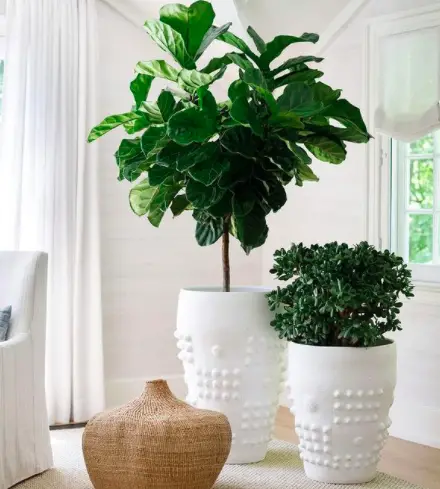
A well-grown Dracaena marginata, the Madagascar dragon tree, with its treelike form and spiky foliage, looks especially good in a simply furnished, modern room. So do many of the palms, such as Howea belmoreana, the curly palm, or Chamaedorea elegans, the parlor palm. In older-style houses, plants with softer, more rounded, and less aggressive outlines are often more appropriate.
Climbing plants, trained up supports, can also make excellent specimen plants, and their eventual height can be controlled. Monstera deliciosa, Philodendron scandens, and Epipremnum aureum will all make large and statuesque specimens. Specimen plants are best displayed where they do not have to compete for attention with elaborate furnishings: give them some space to themselves. Plain walls allow the foliage and outline of the plant to be properly appreciated; patterned wallpaper tends to create a confusing effect unless the pattern is very subtle.
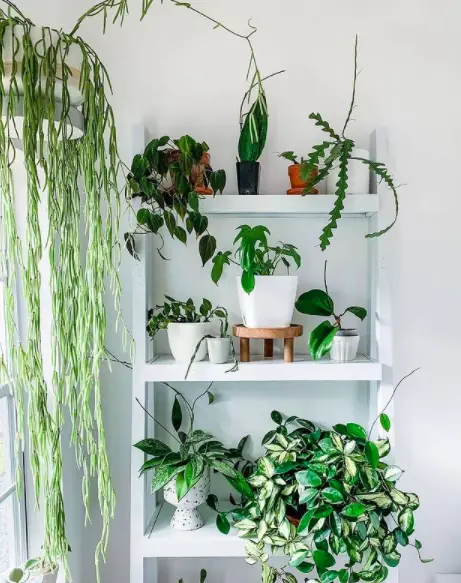
Light-colored walls display most plants well, although pale and variegated leaves may show up better against darker backgrounds. Use lighting to complement the plant and give it a new dimension after dark. Completely different effects can be achieved with low-level and high-level spotlights, and backlighting can give dramatic results when used with boldly cut foliage. Glossy-leafed plants are given extra sparkle with artificial lighting, but the foliage must be kept clean and bright. Specimen plants are normally placed on the floor for the most satisfactory effect, although smaller plants can be set on low tables. Choose a decorative pot that will balance the height and width of the plant so that it does not appear to be top-heavy.
Plant groups
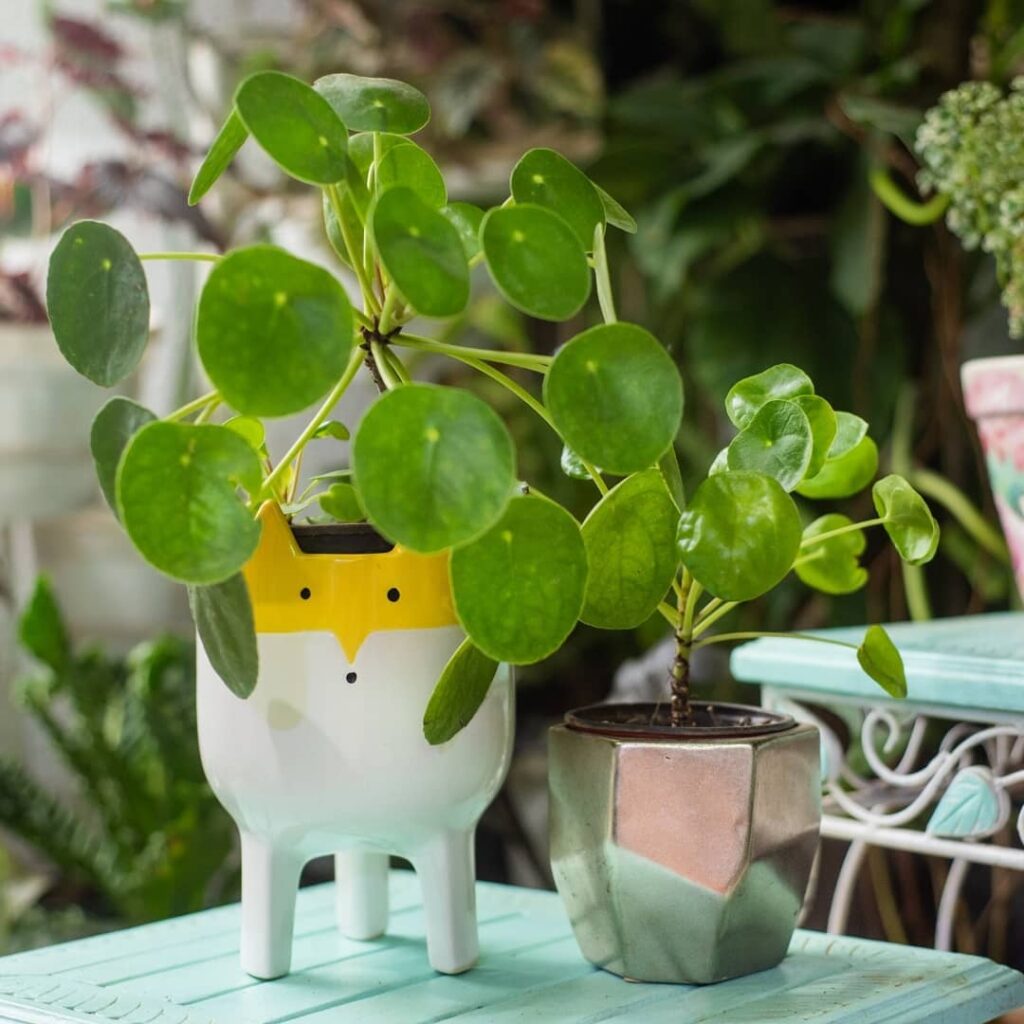
Grouping a number of different plants together has several advantages. It allows you to create a satisfying display with contrasting or complementary foliage types; short-term flowering plants can add welcome color and interest since they can be removed or replaced when their blooms die back. Plants with ungainly shapes or leggy stems can more easily be disguised. And a plain-leafed plant that would look dull alone makes its own valuable contribution when set among other foliage or flowering plants.
Not only do plant groups often look better, but they also tend to grow better too, for the humid microclimate that provides excellent growing conditions is created within the group. It is also easier to look after plants when they are together than when they are dotted around the room: you are less likely to overlook them, and watering is less of the chore. Plants that are grouped together should all enjoy roughly similar conditions of warmth and humidity. Light is less important because it is easier to accommodate varying needs by strategic positioning.
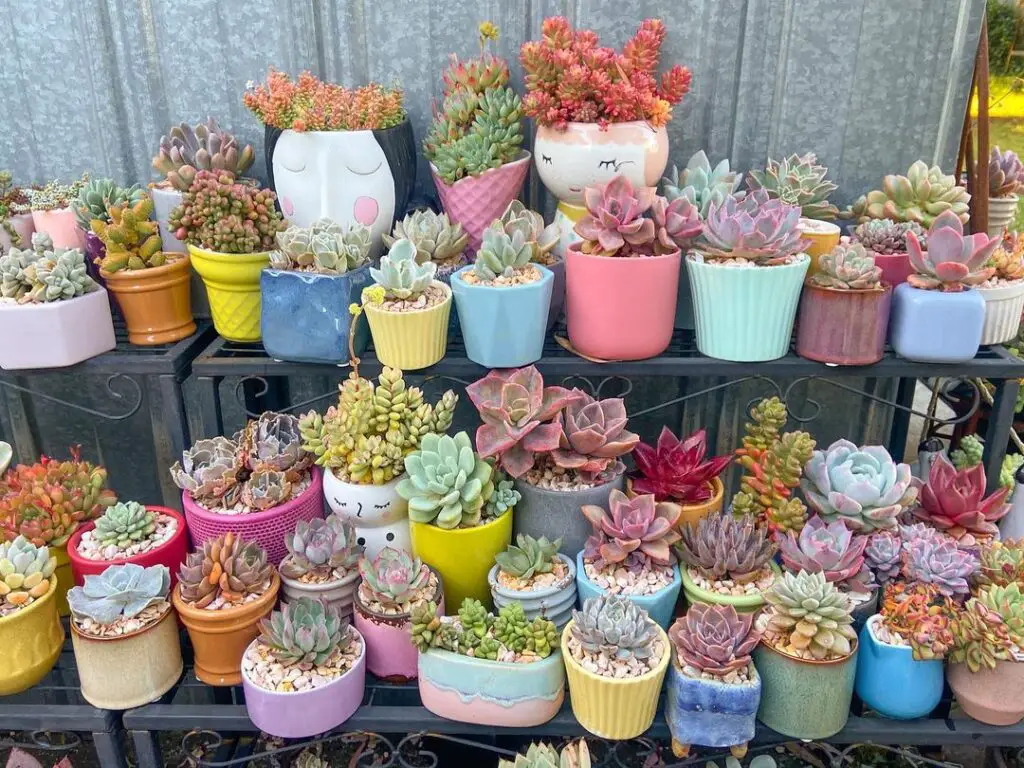
The easiest way to create a group is simply to bring together plants in their individual pots arrange them on a windowsill or tabletop. The pots should be similar: plain terra-cotta ones are usually more pleasing than a variety of different colored or patterned containers. Saucers are necessary for effective watering and to prevent furniture from being spoiled by drips. If you do not want individual saucers, the plants can be placed together on a large tray. If the tray is half-filled with pebbles or gravel, you can easily increase the humidity around the group by pouring water into the tray to just below the top of the gravel. Or you can put the plants in a deeper, ornamental container that will cover the individual pots entirely (see p. 25).
Already-planted groups in decorative containers can be found in many stores and garden centers. Do not expect these plants to have a long life, however. They are planted closely in small containers for instant effect and are chosen more for their appearance than for their similarity of needs. They should be regarded as short-term decoration, although individual plants can usually be saved if the group is dismantled and replanted once it begins to look jaded.
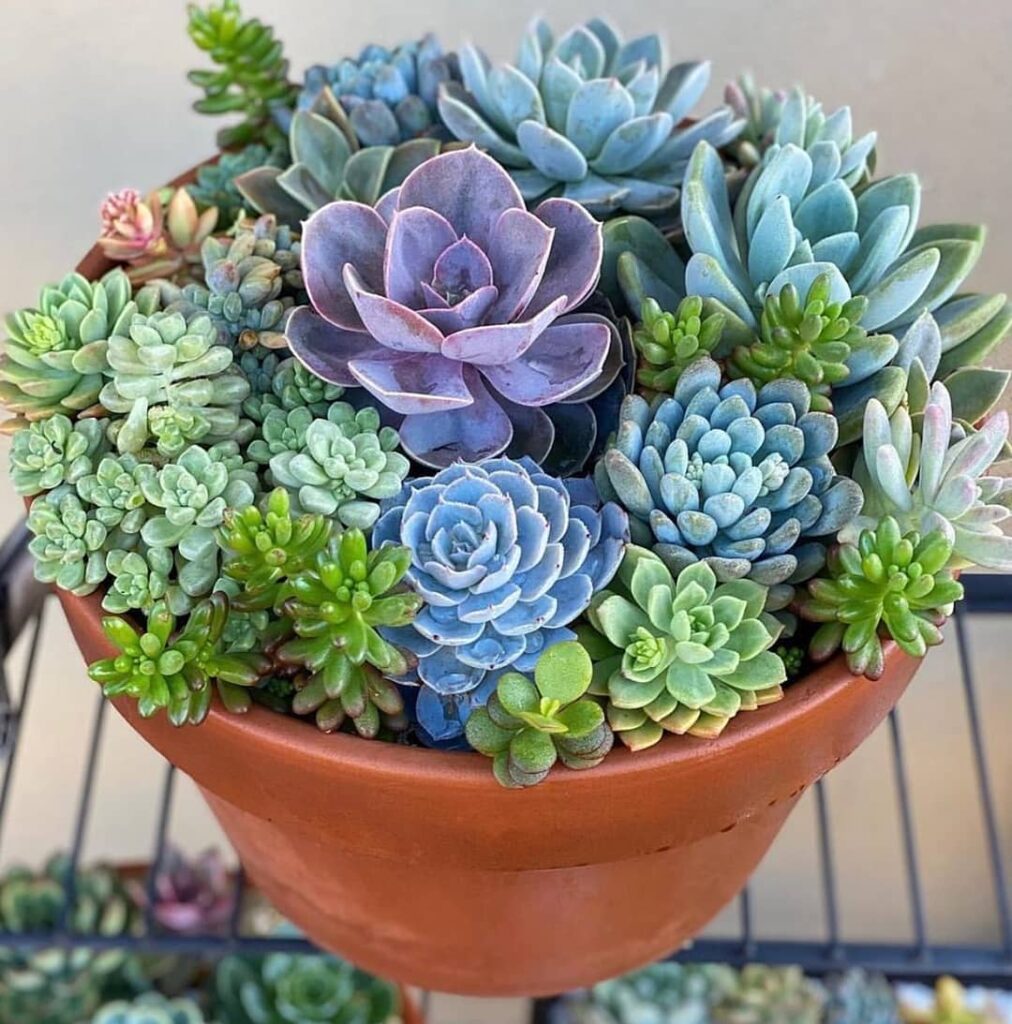
Large architectural plants need large modern uncluttered spaces to show to greatest advantage (left). This fine Ficus benjamina is well placed; it is the focus of attention at the entrance to the two minimally furnished and neutral-colored rooms, and at the same time it draws them together. A wide windowsill in a more traditional type of house (right) calls for a completely different treatment, with several plants grouped together. The grouping is not, however, random. The busy patterning of the pots and pitchers is given unity by their coloring and is offset by the block of red of the cyclamen and the strong color accent provided by the purple African violets.
Handle with care.
Some houseplants need to be treated with caution, especially if there are children or pets in the home. A number of species are poisonous if eaten, and others can cause skin irritation or scratches. Children are probably unlikely to eat many houseplants, but brightly colored berries are tempting. Cats, particularly, and some dogs may chew a wide variety of plants, though they rarely seem to come to any harm.
Choosing Plants For Groupings

Plant groups usually work best if they have some sort of theme—color, texture, or shape—rather than being a haphazard mixture. Groups of plants from within the same family are often successful: cacti, for example, or air plants or spring bulbs. One advantage of this method is that all the plants will enjoy the same growing conditions.
You may wish to compose your group entirely of the same species of plant, perhaps contrasting varieties and a range of flower or leaf colors, such as are found among Saintpaulias (African violets) or Coleus blumei (flame nettles.) Or you may prefer the massed effect of three identical point- setting plants or florists’ chrysanthemums.
With foliage plants, using a range of different shades of green can be effective, and a strongly variegated form is emphasized by displaying it among plants with plain leaves. The color of the variegation can be echoed by flowering plants, with the white markings of the weeping fig Ficus benjamina ‘Starlight,’ for example, being picked up by a white chrysanthemum or white campanula.
Colors in the plant group can also be used to reinforce the color scheme of the room itself, or of a particular ornament or painting. Contrasts can be used effectively, with pale green walls forming a background for a group of dark green foliage plants enlivened with a brilliant scarlet poinsettia or a striking yellow kalanchoe, for instance.

Different-textured leaves also make interesting companions. Several species and varieties of peperomia and pilea have rippled or corrugated foliage, and some have variegation and stripes as well. Asparagus densiflorus ‘Sprengeri’ makes a bright green haze to contrast with the sharply upright spikes of the pineapple, Ananas comosus, or the leathery straplike leaves of a clivia. The softly furry leaves of Columnea gloriosa and Gynura ‘Purple Passion’ seem to be just asking to be stroked, but spiky dracaenas and cordylines warn off would-be touchers.
One of the most pleasing ways to arrange a group of plants with different forms is to create a triangular shape, with one or two tall plants and a number of lower, more spreading types below them. The apex of the triangle can be in the center of the group or to one side of it. If all the plants are much the same height, it is sometimes a good idea to raise one of the pots to vary the level of the group.
Finding the right place
The windowsill is probably the most popular place for any houseplant, but some, especially plant groups, deserve a more prominent position. A large group, with one or two tall specimens, is ideal for a place on the floor near patio doors, where the plants help to link the house with the garden outside and will enjoy the good light.
Smaller groups may occupy a display table or take the central position on a dining table. A fireplace is often the focal point of a room, and in summer the hearth can house an attractive collection of indoor plants.
A color theme of reds, yellows, and oranges, which mimic the flames, or Plants with several different leaf shapes in shades of white, green, and cream are harmoniously combined in this arrangement for a hall. The tall, pale orchid provides the focus of attention, with the other, lower-growing plants grouped at its base.
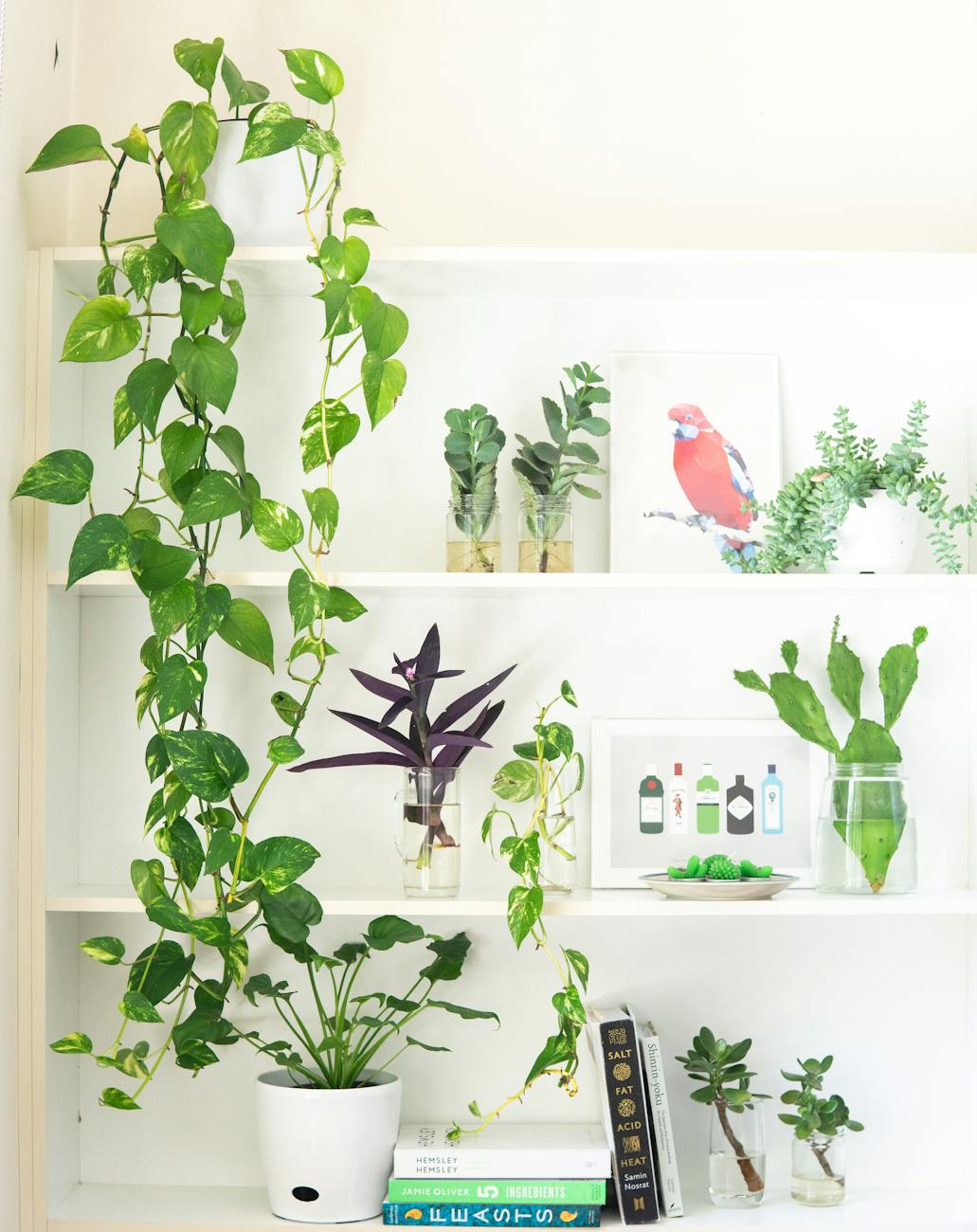
Cool blues, greens, and white emphasizing the summer season both work well. In summer the mantelpiece is also a good location for plants, particularly trailing varieties. A mirror behind the display doubles the effect, but extra care must be taken with the arrangement of the plants in this instance. Always take the plants’ needs, as well as their esthetic effect, into account when choosing their location. A group of plants may well brighten up a dark corner, but they will not stay in good condition for long unless supplementary lighting is used. Do not position plants where people walking past will continually brush against them. The brushing is very likely to damage the plants, and it is annoying as well. And make sure that plants are safe and secure—not likely to topple over or drip water onto expensive furniture or carpets or electrical equipment.
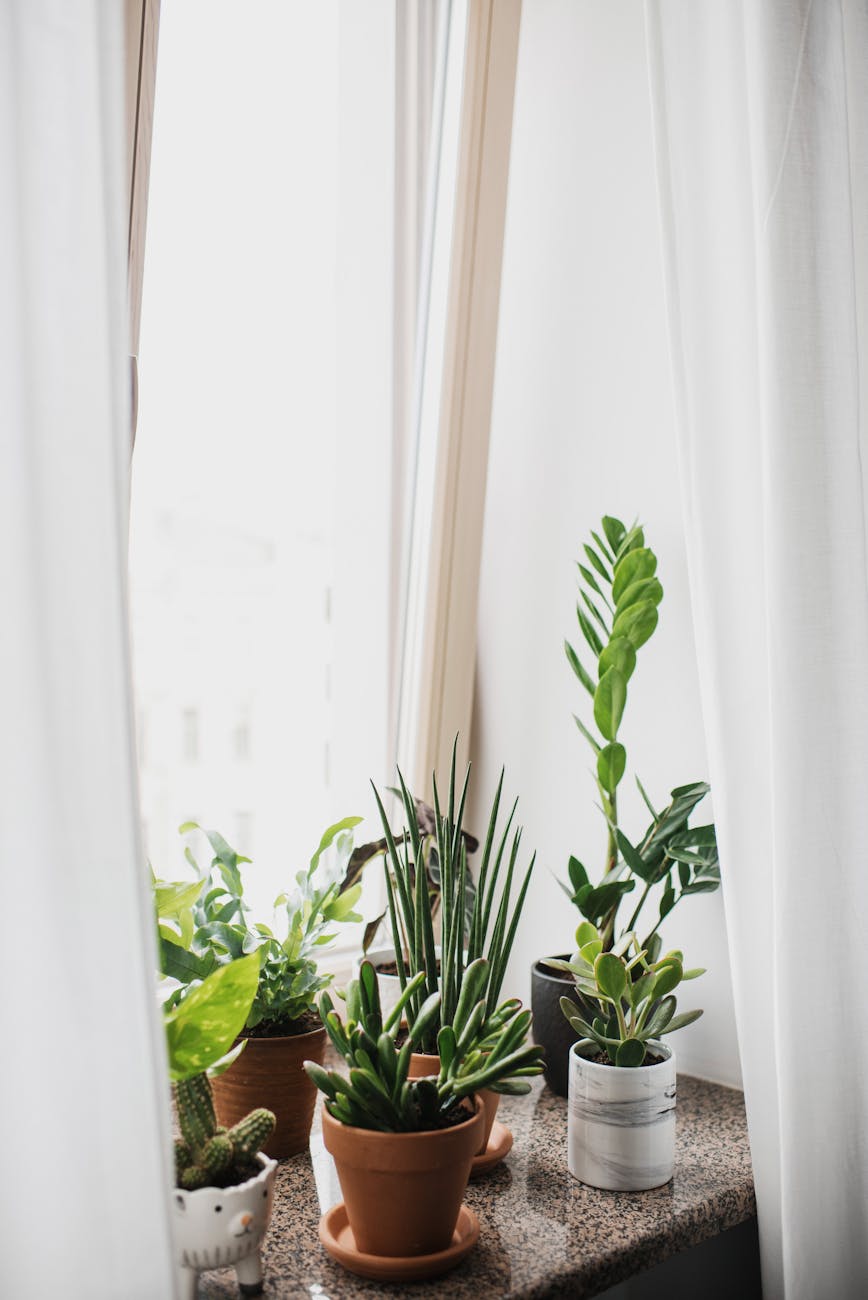
A rough-textured sunny wall and brilliantly colored pots form a pleasing setting for this group of various cacti, a partridge- breast aloe, and a succulent, all of which look quite different but have similar growing requirements—an important consideration when you are grouping plants.
African violets, massed in a shallow china bowl and ranging from pale to deep mauve and pink to ruby red, are the ideal choice of plants here. They echo both the colors and the old- fashioned charm of the antique porcelain figurine, drawing the eye to it and at the same time providing a glowing pool of color among the otherwise cool neutrals of the room.
Containers
Plants need to take up water and nutrients in order to survive, and the substance from which they normally obtain these is soil or, in the case of indoor plants, potting mix. The soil for houseplants needs to be in a container of some sort, the size, and shape of which determines how well the plant will grow and what type of root system it will develop to support itself.
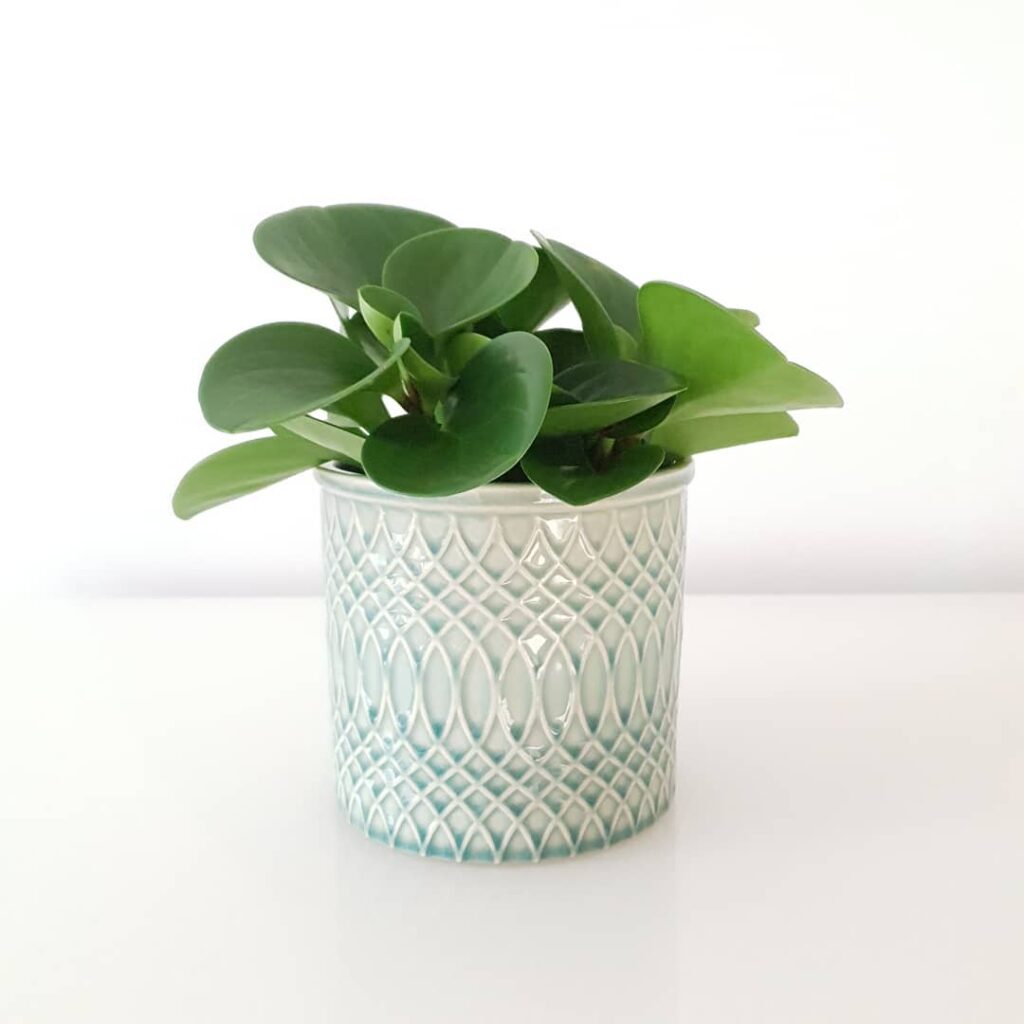
Most plants are obtained in a standard plant pot, generally made of plastic, although some garden centers and florists like to repot plants in terra-cotta or decorative ceramic containers for sale. The size of the pot required varies according to the size of the plant, and as plants grow, they will need to be transferred into bigger pots. A blue textured wall emphasizes the cool greens in this group of foliage plants; the use of several bowls of the same shape and color gives it added cohesion. Plants flower best when they are slightly pot-bound. Others with shallow rooting systems, such as many cacti, do well in half pots or shallow bowls. In general, however, the height of the pot is equivalent to the width across its top, and the pot tapers to about two- thirds that width at the base.
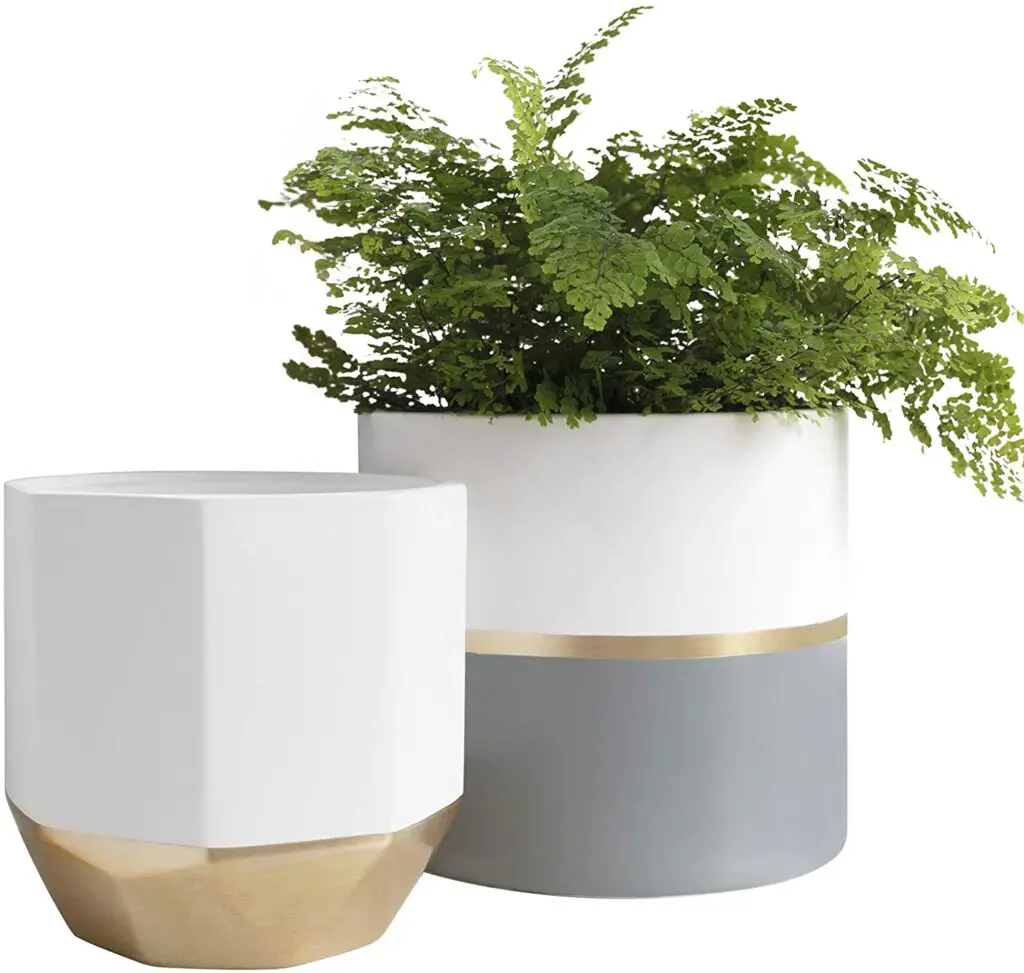
The size of the container is important for stability; top-heavy plants are prone to falling over, especially when the soil dries out. This occurs more frequently with lightweight plastic pots, so it is better to plant tall or large top-heavy plants in clay pots. Clay pots have a central drainage hole in the base; plastic pots usually have a number of small holes along the circumference of the bottom of the pot. Some plastic pots are terra-cotta colored, but many other colors are used as well. Green pots are common, as are black and white ones. You may also see some bright red and yellow ones. As far as the plant is concerned, the container must hold enough soil, from which the plant can absorb nutrients and water. Allow for drainage so that the soil does not become waterlogged.
Be of adequate size to allow the plant to develop a branching root system to balance the head. Give stability, allowing the plant to develop and maximize its exposure to light so that photosynthesis can take place. Secondary to these considerations are those of the plant’s owner that the container should be attractive and should complement both the plant and its surroundings. When you buy a new plant, check that the pot it is in is large enough to fulfill the plant’s needs, and repot it if necessary. In most instances, it is best to use a standard plant pot, which can then be placed in a more decorative container. Many ornamental containers do not have adequate provision for drainage for plants to be potted directly into them.
Choosing a container
Houseplants can be planted in a wide selection of attractive and unusual containers that will add greatly to their appeal. Single plants can easily be placed in a decorative container or cachepot. These colorful or ornamental containers conceal the standard flowerpots. They are widely available and may be made of plastic, ceramic, glass, wood, china, tole, or even wrought iron.
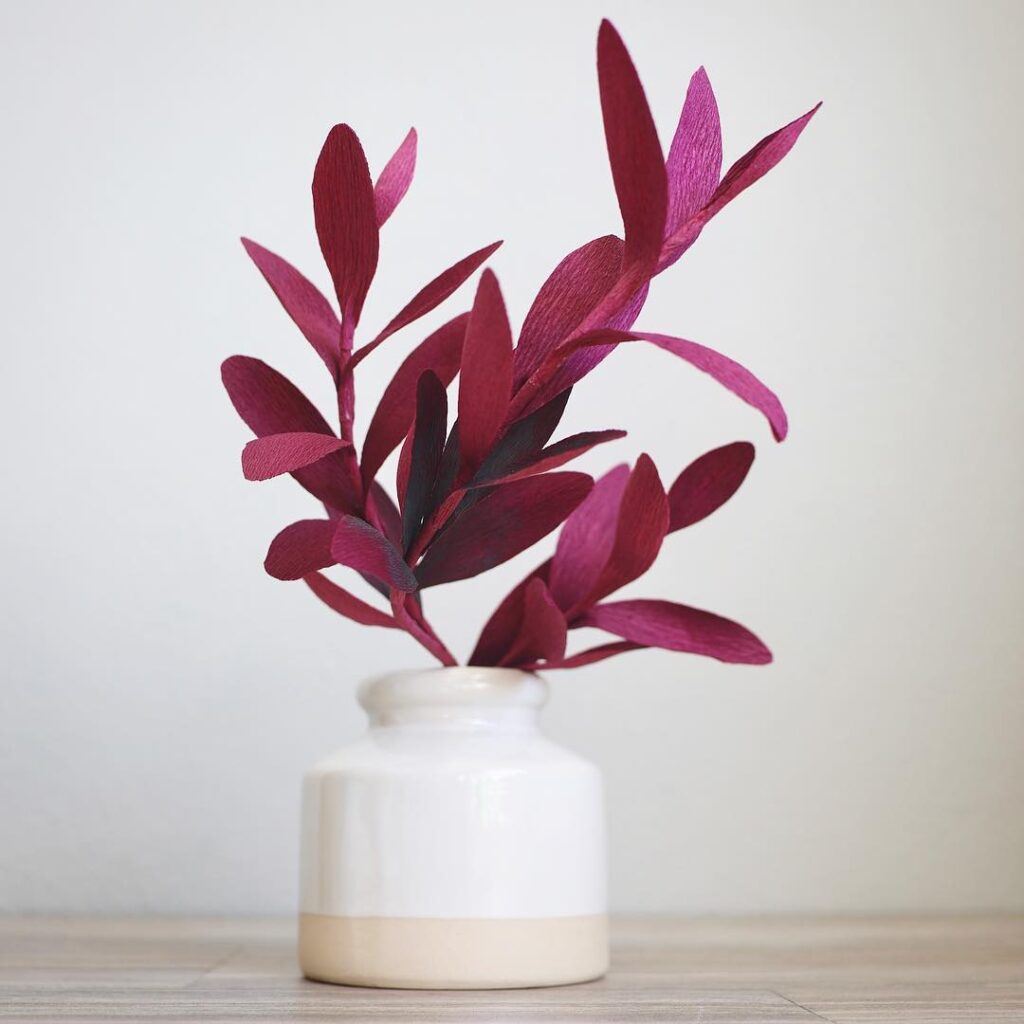
Most of these decorative covers do not have drainage holes, which means that they can double as plant saucers to make watering easier; they also help to protect furniture. If the height of the pot allows, place a layer of gravel in the base of the decorative cover before putting the plant into it. This helps to increase the humidity around the plant. But you need to make sure water does not collect around the roots and cause root rot.
Larger containers can be used to house plant groups. You can find plenty of troughs in a choice of styles. And other household items, such as the attractive washbowls that years ago were found in bedrooms everywhere, can be used too. Brass, copper, china, wood, wicker are all suitable. Once you start looking, you will find many attractive items to house your plants in. If you have any doubt about their being waterproof, it is best to line containers with plastic; even metal and china containers can be damaged by soil and moisture and may need protection.
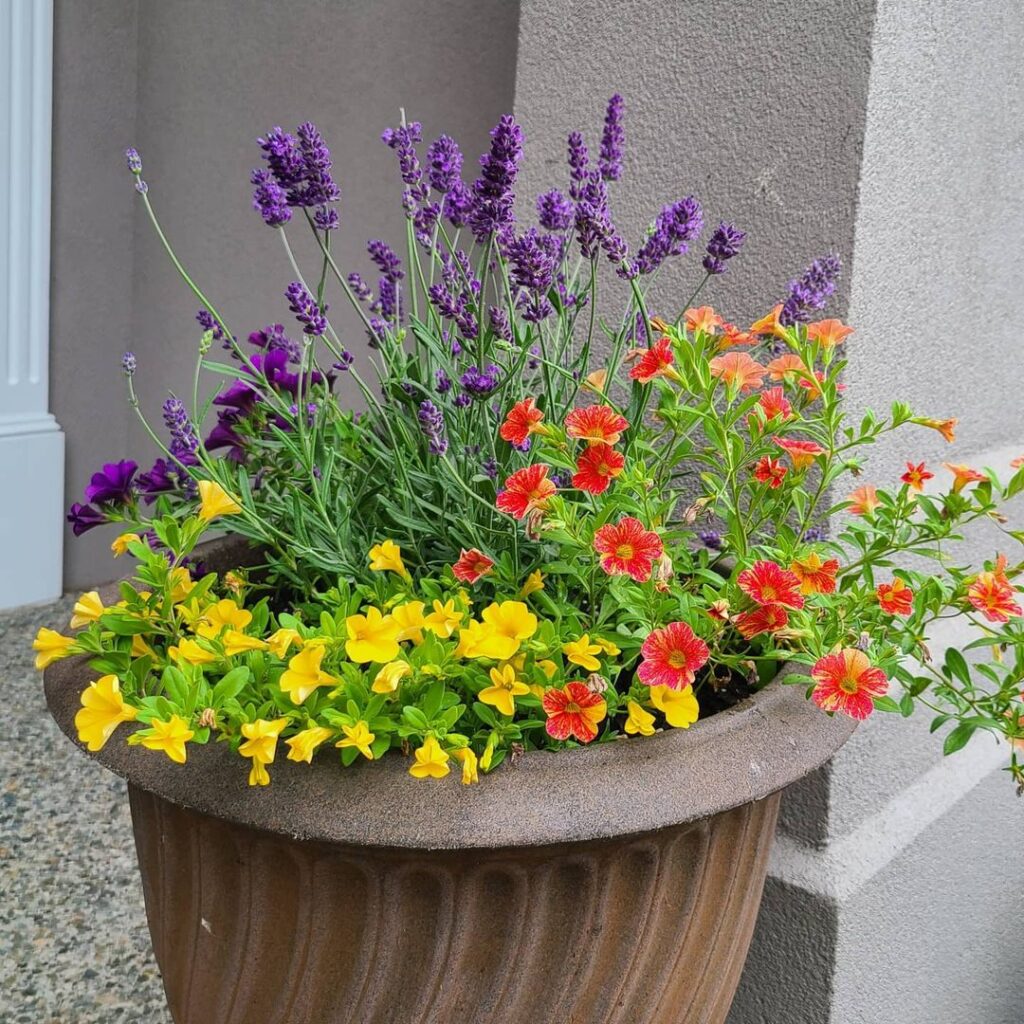
When setting a group of plants within a larger container, it is always advisable to keep the plants in their individual pots. This is so because of the drainage problems and because it is much easier to replace one or two plants when they have finished flowering or if they become sickly. If you want the plants to appear to be growing together, fill around and over the individual pots with peat moss to disguise them. Again, place a layer of gravel in the base of the container first. Novelty containers are usually attractive for only a short time: copper kettles and watering cans, teapots, cups and saucers, even old boots have been pressed into service with mixed results. As long as the container is large enough for plants to remain in their own pots, no harm is done—the container can be changed when you tire of it. But beware of small, planted novelty containers; it is usually impossible to extricate the plants, so the planting may have to be treated as a rather expensive, short-term decoration.
Suit the pot to the plant
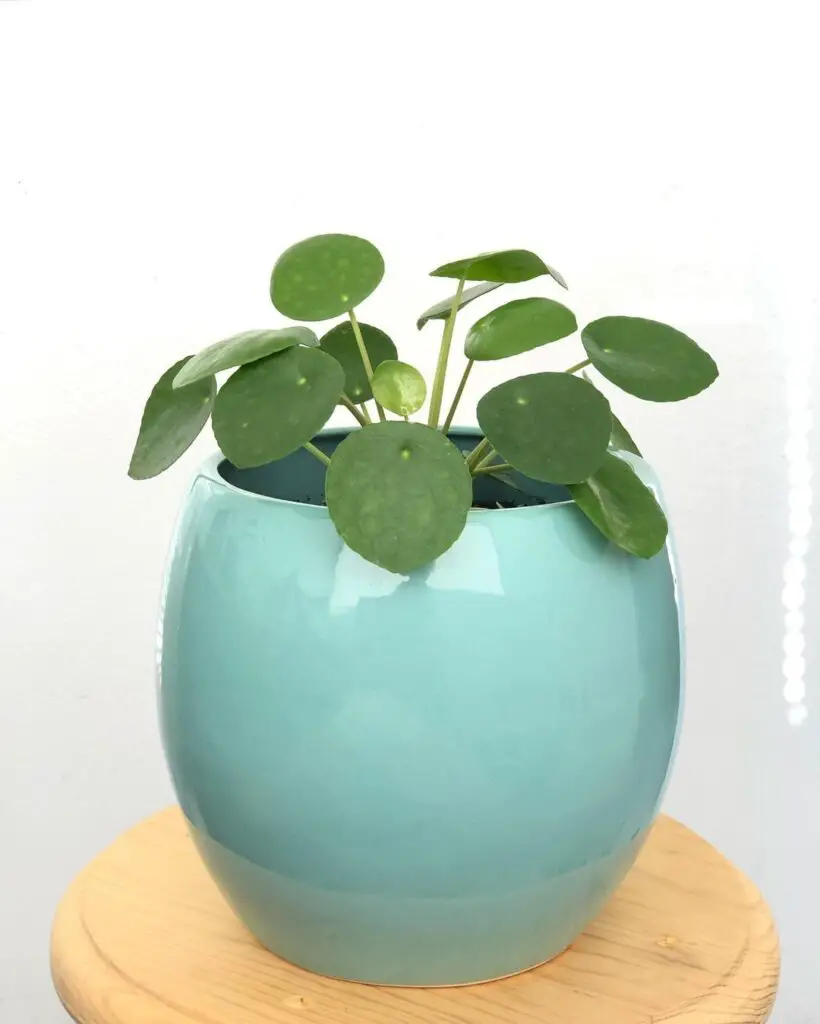
The shallow-rooting primulas’ pink flowers are set off by the low green bowl, and the impact of the hyacinths is enhanced by ranging them in a long ceramic trough. A small terra-cotta pot has the right earthy feel—and good drainage—for the cactus, a sturdy aluminum can make a fine contrast to the yellow and orange flowers of Justicia pauciflora, and a green glass pot is a perfect foil for the dainty Primula obconica.
A WELL-POTTED PLANT
Choose the pot with care. Clay pots are heavy and are good for large or top-heavy plants. Plastic pots are more practical because the soil does not dry out so rapidly. The height of the pot should be equal to the width across the top, although this will vary according to the type of plant.
Bottle Gardens And Terrariums
Plants grown in a sealed glass container creates their own, separate, virtually self-sustaining environment. A well-planted bottle garden or terrarium is attractive and easy to look after, but both the container and the plants must be chosen with care.
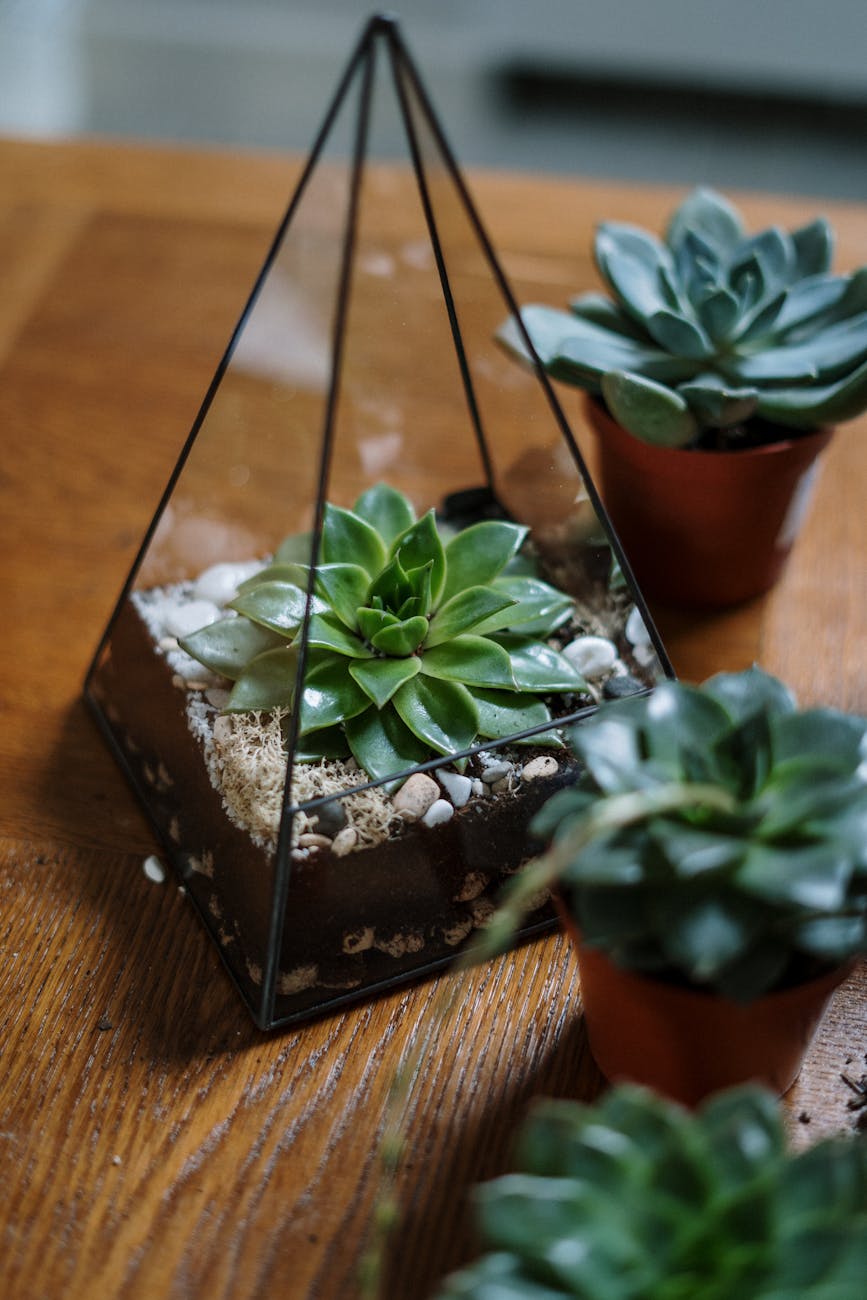
A wide range of containers is suitable, including candy jars, goldfish bowls, fish tanks, and even large brandy glasses. Try to choose one with a stopper so that it can be sealed, although clear plastic or plastic food wrap can be stretched tightly over the top of some glasses and jars. Specially made bottles are available for planting, but they are sometimes tinted green, which interferes with the growth of the plants. Choose clear glass or the lightest tint you can find. Terrariums like miniature old-fashioned greenhouses in
A terrarium shaped like an old-fashioned greenhouse with open sides is easier to plant and water than a bottle. It is also easier to care for plants and replace them when they become too large. Appearance is easier to plant and extremely attractive, although they tend to be expensive. Plastic versions are cheaper, but they may not have the same appeal as glass ones.
Planting
First, wash out the container with water and detergent; then fill it with water that contains some bleach or disinfectant to kill off any fungus spores and rinse it thoroughly. Make sure that the inside of the container is completely dry before planting it.
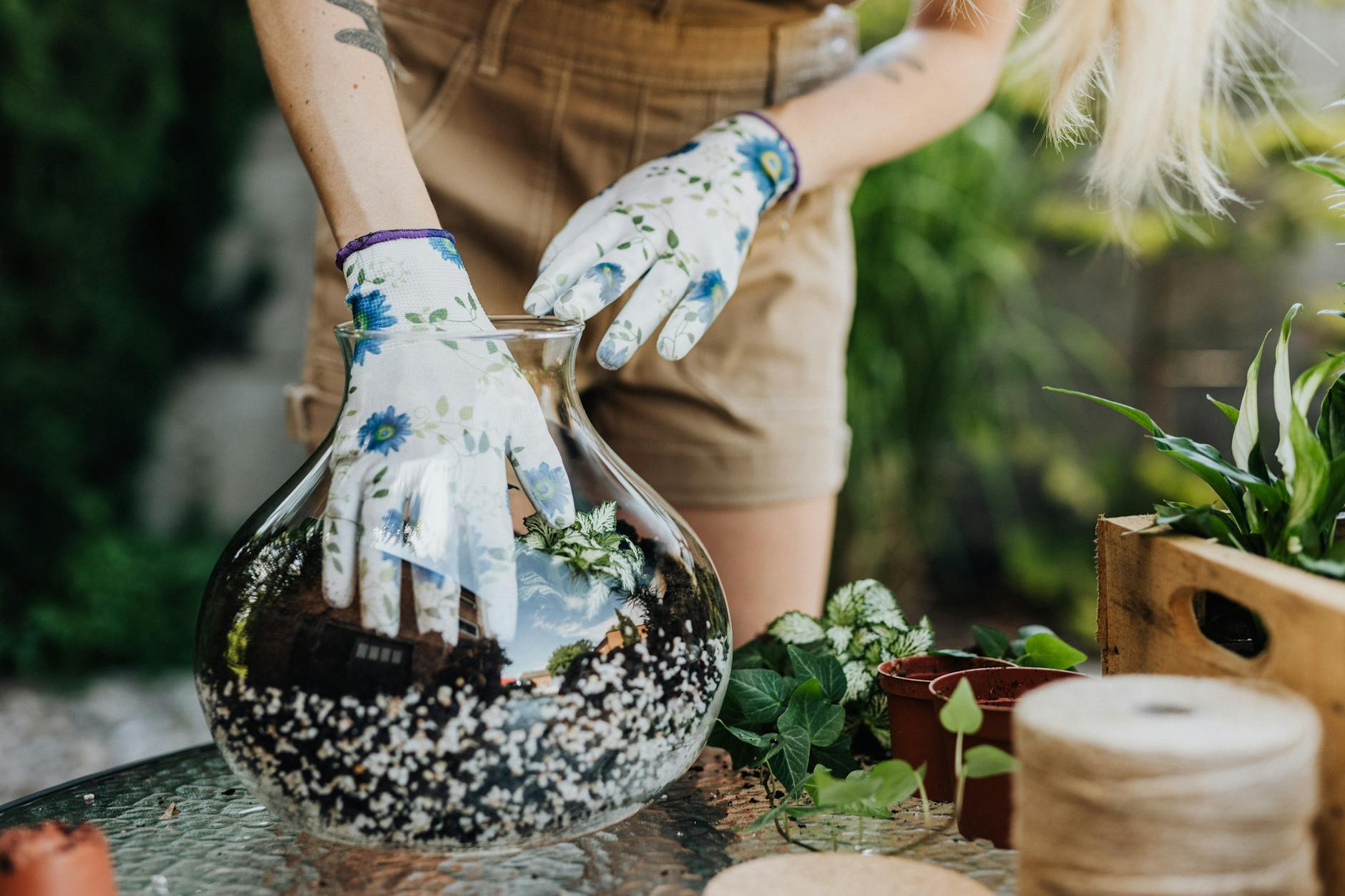
Start by pouring in the gravel until there is a layer about lin/2.5cm deep in the bottom. (With a narrow-necked bottle, use heavy paper or cardboard rolled into a funnel to pour in the gravel.) Add a thin layer of charcoal pieces to keep the soil sweet, then add 2-3in/5—8cm of the teat-moss-based potting mix. Landscape the mix to produce a slight slope. You will find it much easier to plant the bottle if the opening is large enough for your hand to pass through. For planting narrow-necked bottles, you will either have to buy special tools or improvise by tying a fork, a teaspoon and a spool to long stakes to use as planting and farming tools.
Plan the arrangement of the plants before you start to plant them. Take into account whether the garden will be viewed from one side only or all around. Remove the plants from their pots and tease out the roots; wash off some of the soil and trim the roots if necessary. Scoop a hole in the potting mix with the teaspoon, insert the plant by holding it between two stakes, and firm it gently Into place with the spool.
Aftercare
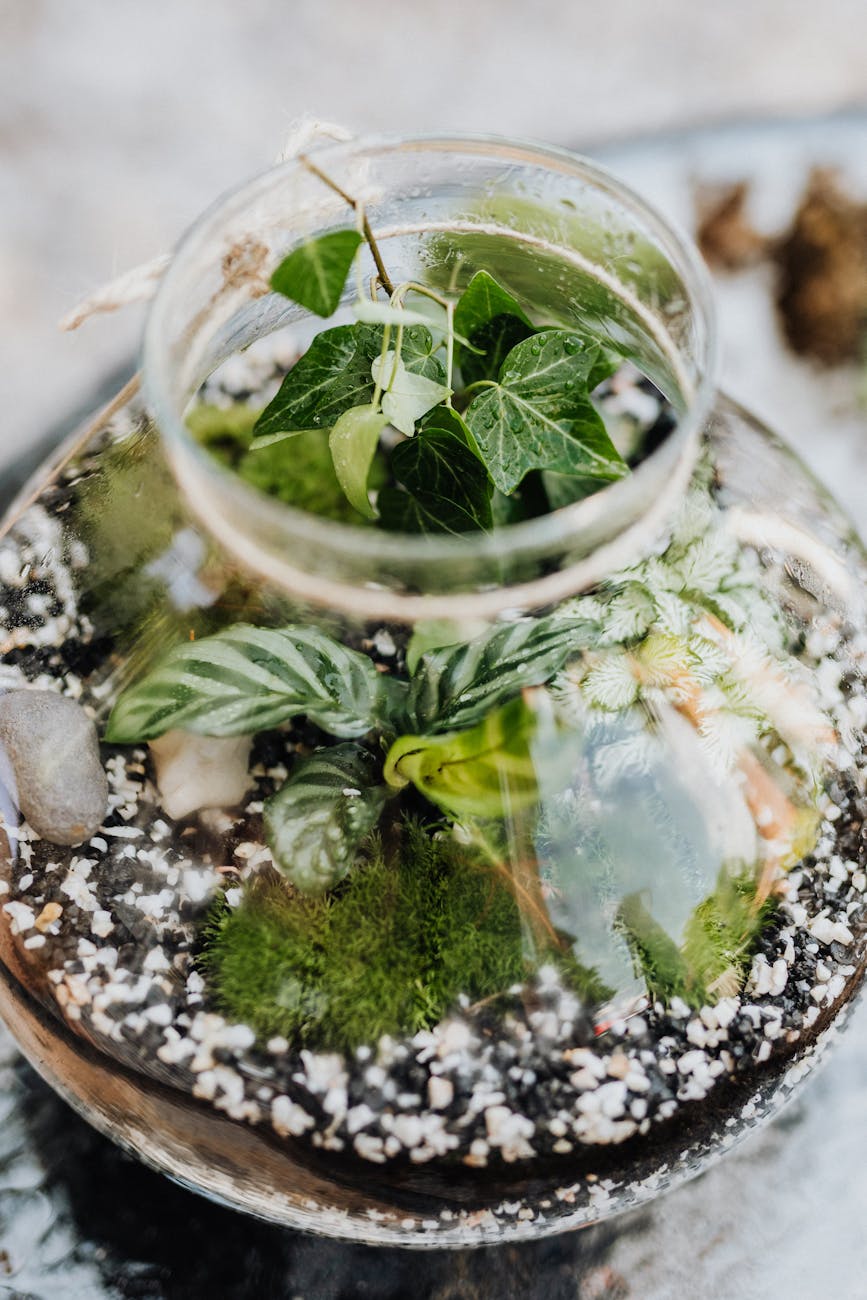
When planting is finished, cover the surface of the potting mix with a thin layer of fine sand. Trickle some water down the sides of the bottle to wash any soil off the glass and moisten the potting mix; lightly mist the plants in a terrarium. Leave the container open for a few hours after planting, then replace the stopper; if there is no stopper, stretch some self-clinging plastic film or food wrap over the mouth of the container or close the door of a terrarium.
If the inside of the glass mists over and will not clear, ventilate the container for a short while. Changes in temperature will bring about temporary condensation, but once the garden has settled down, neither watering nor regular ventilation should be necessary. Keep the bottle garden or terrarium in a position where it receives good bright light but not direct sunlight.
Plant supports
Many plants need supports to keep them shapely, to hold up flowering stems, or because they are climbers any type of support should be as unobtrusive as possible. Climbers that produce aerial roots, such as Monstera deliciosa, the Swiss cheese plant, will grow well around a moss pole or a synthetic substitute. To encourage the roots to grow into the moss, the pole should be kept moist by frequent misting or by watering it through a tiny thumb pot set in the top of the moss. A deep container filled with the soil-based potting mix is necessary to provide adequate stability for a tall pole.
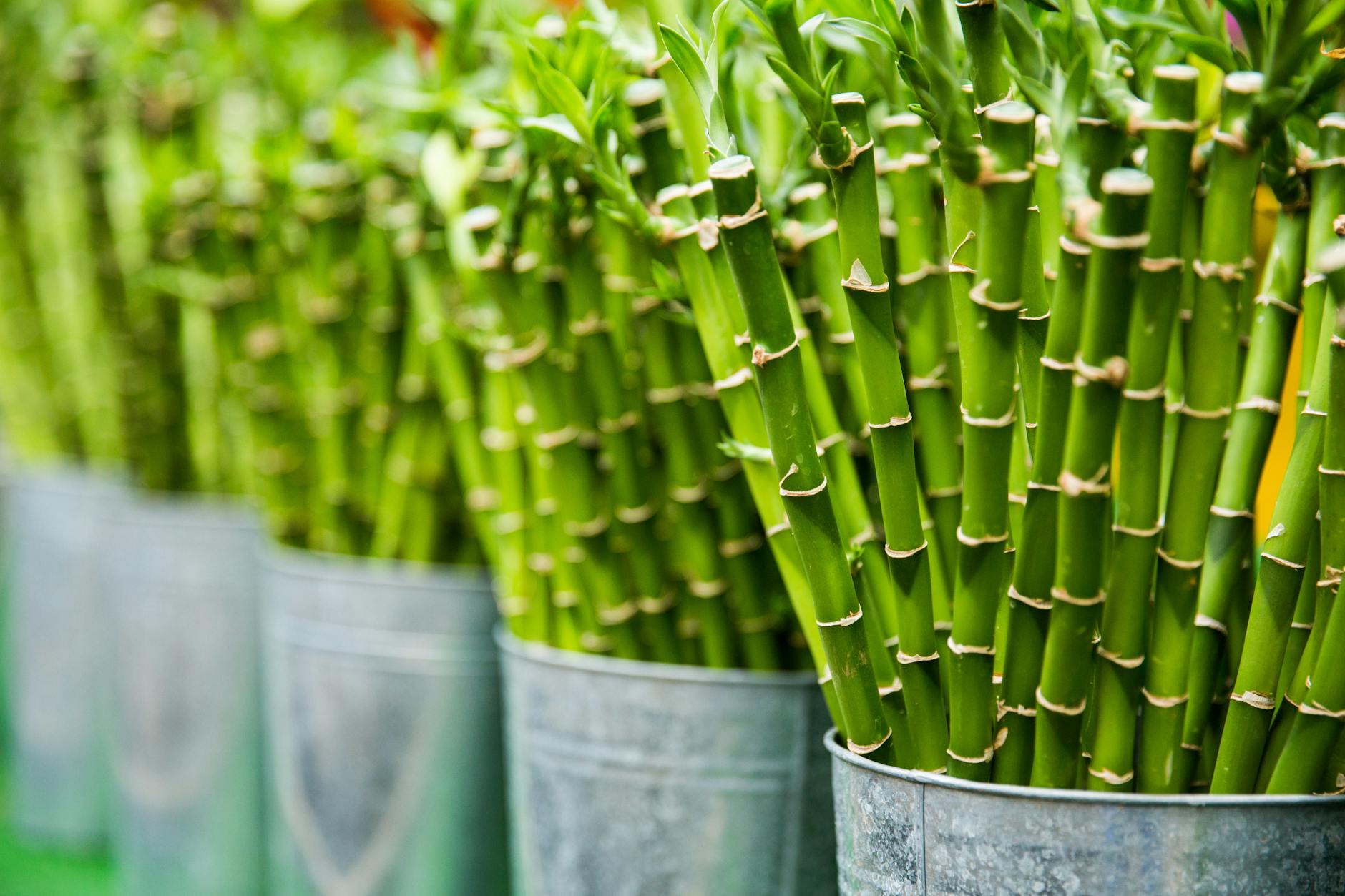
Jasmine and other climbers look attractive trained around wire, plastic, hoops. This keeps the plant neat and encourages flowering by bending the shoots down and slowing the flow of the sap. Two hoops set at right angles will form a plant ball.
Trelliswork, of wood, wire, or plastic, can take the form of a fan inserted into a pot or can be attached permanently to a wall to support scrambling plants. A freestanding trellis covered with a vigorous climber makes an attractive room divider.
Split bamboo stakes are useful as temporary support or for training a wayward stem. Green stakes are the least conspicuous; cut them so they do not show above the plant. Use soft twine or plant ties to attach stems gently to their supports; a figure-eight loop prevents stem damage.
So here In This article, I have spent much time and give full effort to help you how you can decorate your house with these indoor house plant decorates ideas and guides.
Share this article on social media and help us to spread the green environment and help the people also. If you have any question feel free to comment or contact us.